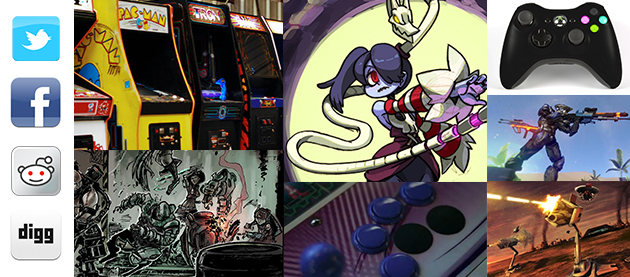
Setting up a gaming crowdfunding campaign is easy. Creating a successful one that reaches its fullest potential takes some more effort though — think of it as the difference between beating Halo on Normal and Legandary. True, on Normal, you can run through the game, leaving a trail of Covenant behind and feel satisfied — but when you beat it on Legendary and get the extended cut ending, it feels so much more rewarding. Given this elaborate gamer analogy, here are my 10 Steps to get your campaign started and finish with a full health bar:
1) Start Early – Start planning for your campaign early. I recommend using the two weeks before your campaign to work with your team on a marketing plan, creating a video, etc. Having a detailed plan for what you should be doing every week during the campaign is key too.
2) Video Time – Though not required, you MUST create a video for your campaign. We live in a visual world and video is key — they are called videogames after all. I know some people are a bit nervous when they hear that they are going to be on film, but there are some ways around this. If you are a bit camera shy, try showing off a gameplay trailer and discuss the campaign over it. Even better –– have one of your characters do the pitch for you! Also, the further along you are in the development of the game, the better contributors tend to like to back games that are past the concept phase. Uploading new videos showing progress as the campaign goes on is great as well.
3) Soft Launch – When you are ready to launch your campaign, think about doing a soft launch first. Start day one of the campaign by reaching out to your friends, your family, and possibly your social media following — all of whom have probably been hearing about your campaign for some time now. Asking them to contribute to the fruition of your dream project or to spread the word through their social media networks is a great way to build early momentum — and get that green bar going to the right. This helps validate the campaign before strangers start flocking to it.
4) PR Push – By the time contributions from your inner circle start to come in, it will be time to reach out to news outlets, bloggers, and beyond to acquire some coverage and bring fresh eyes to your campaign. Before launching your campaign, you should draw up a PR template (campaign synopsis) that you will send out to possible press leads. Be sure to personalize this outreach — sending out bulk, BCC’d messages will easily be disregarded. If you are a smaller dev, posting in dedicated forums that are involved in your specific game type is a great way to gain traction and build up a fan base for your campaign.
5) Get Social – Before the campaign begins, post teasers, videos, and concept images on your website, Twitter, Facebook page, etc. to get contributors psyched about your campaign. As it picks up steam after launching, seek out tastemakers and fans in your genre — and join their conversation! Use special Twitter hashtags when you’re spreading the word about your gaming campaign — such as #fundGameX — so you can track whether your social push is taking hold.
6) Update, Update, Update – A rule of thumb at Indiegogo is: In order to further catalyze the success of your campaign, you should update (using the Updates tab on your campaign page) at least once every five days. Things to put in your updates include Thank You’s to contributors, new images of perks, gameplay, or your team, and gameplay videos. You can also make updates fun — the Skullgirls campaign, for instance, sent out an update for every $20,000 they earned, in which they released an image of another character that fans could vote on to be in the game. As of this writing, they have released 13 characters!!!

7) Dig Deeper, Socially and Virally – Use aggregator sites, such as Reddit and Digg, to reach out to a bigger audience than typical forums. Doing an AMA (Ask Me Anything) on Reddit is also a great marketing tactic to create a closer bond with your audience.
8) Gamify Your Gaming Campaign – Think about having referral contests for your campaign, in which top referrers to your campaign (in terms of contributions, site views, or press) are rewarded with a new perk or other special bonus. This is a great way to keep your contributors engaged in the campaign by incentivizing sharing — it allows them to help you fund your game beyond their initial contribution by doing some of your marketing legwork for you.
9) Stretch Goals and Perks – Once your campaign starts to approach or exceed its goal, you should think about ways of keeping the momentum going. Adding stretch goals and new perks is a great way to do this. One campaign that did an excellent job of this was Starforge — they added an infographic of a temperature gauge at the top of their campaign, which easily tracked the progress of the campaign toward its stretch goals.

10) Can’t Stop, Won’t Stop – Once the campaign has finished and you have been successfully funded — first off, Congratulations!!! But…your job is not over. You will want to keep sending out updates, informing your contributors on how game development is going. Not only will this help guide expectations on release dates, but it will also keep your marketing push alive for when your game makes it to market — keeping your fans and contributors engaged all the more.

Feel free to reach out to me to get your campaign started,
John Vaskis (@gogoJV) — Indiegogo’s Gaming Geek
If you found this post helpful, tweet it to your followers — and check out other gaming campaign funding on Indiegogo right now!
One Response
You must be logged in to post a comment.



There is so much that goes into crowdfunding games. I’ll sometimes go onto Kickstarter and look up games that people are trying to make. I really admire the people that go onto crowdfunding to do business. https://www.edentreepros.com/tree-services-tree-pruning.php